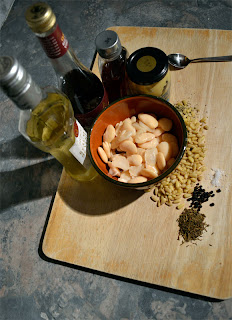This week's recipe is inspired by a reader who made Alexandrian Itria and shared them with us on the Pass the Garum Facebook page. When another reader asked for a recipe for these sweetmeats, I set off on a hunt. Quite by coincidence, I was looking through the rather fantastic Horrible Histories books (what an excellent Christmas present), and I chanced upon the very recipe I was looking for! It's not very Roman, and our source is a kid's book, but all the same we're going to have a bit of fun and hopefully make something tasty.
Egyptian Sweetmeats
Ingredients
- 6 or 7 Dried Dates (OR Date Syrup)
- 1 tsp Cinnamon Powder
- 1 tsp Cardamom Seeds
- 3 Handfuls Walnuts
- 2 tbsp Honey
Methods
- Remove the stones from the dates, chop them into small pieces, and mash them up with a mortar and pestle with some water. You're looking to create a date paste of sorts. If you have date syrup you can use this instead, or combine the two.
- Break open the cardamom seeds to get at the little seeds inside - grind these with a mortar and pestle to make a powder.
- Add the cinnamon and cardamom to the date liquid, and mix it all together.
- Smash up the walnuts so they're not too big, and add to the mixture. Stir this all together to create a very festive smelling walnut/date dough of sorts.
- With wet hands, take a bit of this dough at a time and roll it into little spheres. Mine ended up being ping-pong ball sized, but you can make them smaller or bigger.
- Heat up some honey in a little dish, spoon some cinnamon powder, powdered almonds, and ground pepper onto a plate (or if you're not too worried about being authentic you can use dessicated coconut as I have, or maybe even chocolate powder!).
- Dip each sweetmeat into the honey, and roll it in the dusting of your choice. Let them set for a little bit, then enjoy!
Notes
- Be careful not too have too much liquid in the early mixture, as you'll need a LOT of nuts to make it dry enough to mould into spheres.
Results
The nearest 'modern' food I can compare these sweetmeats to is, perhaps, alcoholic chocolate truffles. The flavours and aromas are all very intense, with the cardamom and cinnamon lending these treats the taste of Christmas. When coated in cinnamon the initial taste can be quite bitter, but it soon transforms into something more acceptable. Almond, a taste which I'm not fond of, lends it that marzipan taste, which I'm also not fond of. Pepper made it pleasantly tingly, but care must be taken not to use too much. Perhaps the outright winner was the ever-so-authentic coconut covering, which I urge you to try if you make a batch.










